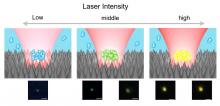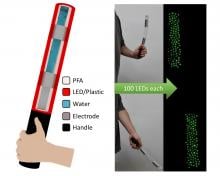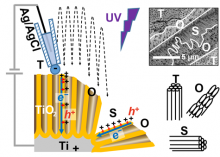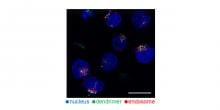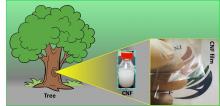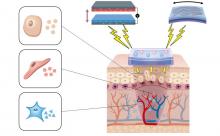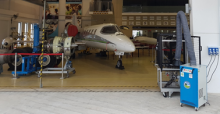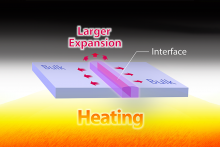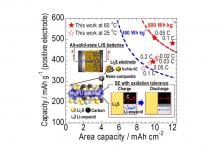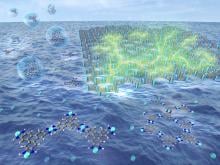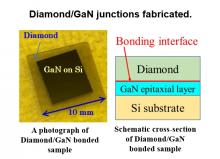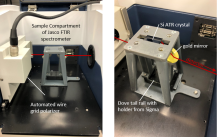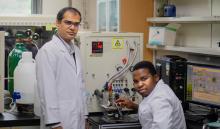Engineering & Technology Materials Science and Engineering
News
28 Feb 2022
Scientists demonstrate an optical trapping technique using nanotextured black silicon that can efficiently trap polymer chains. By adjusting the laser intensity, these “optical tweezers” can control the florescence color emitted through a local concentration of a perylene-modified polymer solution. From a low intensity blue to high intensity orange, this reversible and fully remote technology can almost reach the entire RGB spectrum.
18 Feb 2022
The compact, lightweight device generates electricity when shaken and can power 100 LEDs.
17 Feb 2022
In a recent study published in the journal ACS Catalysis researchers from Kanazawa University describe novel scanning electrochemical cell microscopy measurements to determine sites of photoelectrochemical activity in titanium dioxide nanotubes.
16 Feb 2022
This is a novel study that attempted to construct a pH-sensitive delivery system into T cells and their subsets using carboxy-terminal Phe- and CHex-modified dendrimers with different structures, i.e. PAMAM-CHex-Phe and PAMAM-Phe-CHex. The findings contribute to the development of nanoplatforms for direct delivery to T cells to control the functions of T cells, which play key roles in cancer immunotherapy. This is the first report on direct delivery into T cells using pH-sensitive DDS.
11 Feb 2022
Low volcanic temperature ushered in global cooling and thriving dinosaurs, Broccoli compound induces cell death in yeast, A single molecule makes big splash in quantum mechanics, Dengue virus makes mosquitos bite more often, and Asia Research News: How it all began, all in the February's Editor's Choice
26 Jan 2022
To meet the demand for strong and tough transparent thin films for sustainable applications, Dr Sunanda Roy from GLA University India has led a multi-national team to successfully develop a novel transparent thin film made from cellulose nanofiber (CNF) reinforced by glycerol & glutalraldehyde (reinforcing glycerol).
26 Jan 2022
Accidental oil discharge into the river can lead to an environmental catastrophe, threatening the lives of countless aquatic animals as well as land animals that forms the ecosystem of the river. Preventing and containing many of the oil discharge is key to mitigating the severity of the catastrophe.
18 Jan 2022
Researchers are working to overcome challenges in order to bring wearable, electric, wound-healing devices to clinical practice.
22 Dec 2021
To meet the demand for alternative low-cost, sustainable, light weight and strong materials for two wheelers, Dr JS Binoj from Sree Vidyanikethan Engineering College India has led a multi-national team to successfully develop a novel riser bar made from jute fibre reinforcing isophthalic polymer composite material.
09 Dec 2021
An engineering project team, has been awarded the Institution of Engineers - Singapore, Prestigious Engineering Achievement Awards 2021 in the Research & Development Category. The award was for their work on Replication & Repair of Hot Air Thermal Defects on Composite Aero-Structures.
02 Dec 2021
Researchers from the The University of Tokyo Institute of Industrial Science use electron energy loss spectroscopy to understand local thermal behavior at grain boundaries in polycrystals
04 Nov 2021
A research led by scientists from City University of Hong Kong (CityU) has successfully developed a super-strong, highly ductile and super-light titanium-based alloy using additive manufacturing, commonly known as 3D printing. Their findings open up a new pathway to design alloys with unprecedented structures and properties for various structural applications.
28 Oct 2021
Researchers succeed in developing a lithium sulfide cathode containing a solid electrolyte with high decomposition resistance, enabling the realization of all-solid-state lithium-sulfur batteries that exceed the energy density of lithium-ion batteries
25 Oct 2021
Spontaneous wide-area spreading of oil on water inspires a facile energy-saving route of crafting electrically conductive nanostructures for future sensor/energy devices
29 Sep 2021
A quick, cost-effective approach improves the accuracy with which machine learning models can predict the properties of new materials.
20 Sep 2021
Twisting light that switches direction at room temperature could be the future of quantum information processing.
14 Sep 2021
Researchers at Jilin University, China, reviewed recent progress in the study of Salvinia leaves and their artificial replicas.
09 Sep 2021
Researchers succeed in the direct bonding of diamond and gallium nitride (GaN) at room temperature and demonstrate that the bond can withstand heat treatments of 1,000℃, making it ideal for the high temperature fabrication process of GaN-based devices. GaN-on-diamond semiconductor material will allow for the next generation of high power, high frequency devices.
01 Sep 2021
Scientists from South Korea add foreign atoms to monolayer graphene in a controlled manner to selectively enhance its desirable properties
18 Aug 2021
Scientists in Korea make hand-drawn and flexible pressure sensors that can control a phone from underwater.
18 Jul 2021
Using a CeO2 catalyst, researchers develop an effective catalytic process for the direct synthesis of polycarbonate diols without the need for dehydrating agents. The high yield, high selective process has CO2 blown at atmospheric pressure to evaporate excess water by-product allowing for a catalytic process that can be used with any substrate with a boiling point higher than water.
13 Jul 2021
As rechargeable batteries get more powerful, the chance of batteries overheating –thermal runaway - increases. Seeking a way to make batteries safer, researchers have investigated one of thermal runaway’s main triggers: oxygen release.
05 Jul 2021
Osaka Prefecture University develops a method to design and control the path of electron flow in a polycrystalline material. Using epitaxial growth approach, researchers address the electrical conductivity problem of thin film materials by realizing a highly conductive in-plane orientation of a metal-organic framework. Furthermore, they show that it is possible to fabricate oriented thin film patterns by integration with UV lithography technology.
17 Jun 2021
Researchers at Osaka Prefecture University have established an approach to identify the orientation of molecules and chemical bonds in crystalline organic-inorganic hybrid thin films deposited on substrates using Fourier transform infrared spectroscopy (FT-IR) and polarized infrared light with a 3D-printed attenuated total reflectance (ATR) unit. This inexpensive method with laboratory-grade equipment quickly reaches the crystal-structure model of even extremely thin films of less than 10 nm.
25 May 2021
Scientists develop degradation-mitigating additives that vastly extend the lifespan of Nafion-based fuel cells
13 May 2021
The trick to extremely thin supercapacitors with improved performance is spraying graphene ink at an angle.
12 May 2021
Ion-conducting gels that repair themselves following damage are under development for wearable electronics.
12 May 2021
Heusler alloys are promising contenders for faster and more energy-efficient computing and memory storage devices.
12 May 2021
Printing electronic circuits could soon get easier and cheaper.
12 May 2021
Molecular interactions within gels and rubbers can be controlled to fabricate stronger and more elastic materials.
Events
Sorry, nothing coming up for this discipline
Researchers
Sorry, nothing coming up for this discipline
Giants in history
Sorry, nothing coming up for this discipline


